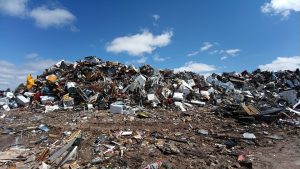Scottish Environment LINK and Stop Climate Chaos Scotland recently held an event to discuss the role of material use in mitigating climate change. The event was organized as part of LINK’s Circular economy for a fairer footprint project, which is campaigning for comprehensive and cross-cutting policies to make our economy more circular.
There has been increasing recognition that we really need to turn our minds to the energy that is embodied in materials if we are to address climate change. Eighty two percent of Scotland’s carbon footprint comes from things we use and consume. Life cycle analysis of products, which enables us to identify at what points in a product’s life cycle most of the impacts occur, shows raw material extraction as the most carbon intensive part of the life cycle of most products.
Understanding more about the materials we use and where they come from is vital to enable us to prioritise our action to meet climate change goals. For example, although switching to electric cars cuts our direct emissions in Scotland our global emissions will remain high due to the emissions embedded in the materials cars are made from. More sustainable transport options such as improvements in public transport are needed to address our overall contribution to climate change.

Our event heard from 3 speakers who are at the forefront of using data to explore the impact of the materials we use on GHG emissions at the global, UK and Scottish levels.
Professor John Barrett, University of Leeds, presented a study which found that by applying a range of strategies to increase the efficiency of how we use materials, UK consumption based emissions could be reduced by 121 million tonnes (approximately 8 times the annual emissions from all forms of transport in Scotland per year). The potential of material efficiency to reduce carbon emissions from industry is found to be double that of energy efficiency (which is where much of the effort has focused to date). Most of this emissions reduction would occur outside the UK where the materials we use are extracted and processed and many of our goods are manufactured; but, although it is our carbon footprint that would see the biggest reduction, the impact on territorial emissions is also significant.
The research found that in terms of emission reduction in the UK, about half the saving could be made from food-based policies – reducing food waste and changing our diets; other key areas being light-weighting (reducing weight) – particularly in buildings and vehicles, and increasing recycling processing in the UK. To reduce our emissions overseas, using products for longer and switching from the sale of goods to the provision of services would provide added carbon savings.
Research at the global level by the Circularity Gap Initiative was presented by Matthew Frazer from Circle Economy in the Netherlands. This research found that circular economy measures could address the emissions gap – the gap between carbon savings linked to policies already announced and those needed to be on track to meeting the Paris Agreement.
We were shown a Sanky diagram showing the flow of materials, and associated carbon, through the global economy which demonstrated how most of the fossil fuels extracted end up embodied in materials and goods. By looking at how human needs can be met in a more material efficient way, the report identified policy areas that could make the biggest impact on reducing carbon emissions whilst addressing societal needs. The research modelled 21 strategies which had a combined effect of shrinking global material use by 28% and global emissions by 39%. Three of the areas where cross-cutting policies could have the biggest potential were identified as buildings (such as making better use of and improving the design of buildings), mobility (for example, urban design to enable mobility with fewer vehicles), and nutrition (including changes in diets and regenerative farming). Together, these three areas could deliver 70% of the required emissions cut.

Kim Pratt from Zero Waste Scotland presented some of the findings of the Scottish Material Flow Accounts, published on the day of the event.
One key indicator calculated is an estimate of our material footprint – the amount of raw materials each person uses in a year. In 2017, each person in Scotland used 18.4 tonnes of materials, higher than the EU average, at 14.1 tonnes per person per year. The sustainable level is considered to be 8 tonnes per person per year which would enable people to live sustainable and high quality lives. Our 18.4 tonnes per year equates to 50 kg of materials per person per week. Remember most of these materials don’t make it into the final product, for example 25 tonnes of iron ore is required to make 1 tonne of steel.
Kim provided insight from a specific example of greener steel reprocessing and the benefits it could bring. We export 820,000 tonnes of Scottish scrap steel for reprocessing every year with a commodity value of £110m. Traditional steel reprocessing relies on coal and so there are associated carbon emissions. However, a modern electric arc furnace uses electricity instead of coal and if we developed such a furnace in Scotland, where our electricity has a very low carbon intensity, we could be reprocessing some of the greenest steel in the world and also saving materials as they take more scrap. This would lead to material, energy and transport savings – 56% reduction in GHGs; 180 direct and 1000 indirect jobs, and an increase in direct gross value added of £10 – 25m per year.

Some additional thoughts were provided by the speakers:
– Stay focussed on the goal. Quantification is important and we need a sense of scale. We need to think about millions of tonnes of materials flowing through the economy and how to achieve societal goals whilst using considerably less materials.
– We need a government wide approach – it is not just the domain of the environment departments. Resource efficiency must be embedded in all operations – how infrastructure is planned and how money is allocated and spent across departments.
– Many of the strategies needed are about optimising the use of carbon intensive materials, such as those that go into cars. Cars are typically idle for 95% of the time and, when in use, usually only 40% full. We need to find ways to collectively access mobility without the need for individual ownership of cars.
– The opportunities are positive and exciting with a huge amount of potential to create new business models for more sustainable living. New business models create positive stories.
– Resource efficiency will struggle to keep up in terms of throughput of materials and greenhouse gas emissions if we have higher growth rates. We will struggle to reduce overall impact unless we change consumption patterns. We need absolute targets to achieve this goal – we need an absolute target in material use and we also need absolute targets in energy demand.
What are our next steps? It is clear that we need a fundamental shift in how we use resources – it is not OK to tinker around the edges, we need transformative change to enable people to do things differently.
There is further work to do to examine the new Scottish material flow data to really pinpoint the material related policies that will have the biggest impact on reducing Scotland’s contribution to climate change emissions. We also need to think about the impact that material use has on biodiversity and start an equivalent analysis to determine key material policies to reduce our impact on land use and biodiversity – remember, 80 – 90% of global biodiversity loss is caused by the extraction and growing of raw materials and their processing.
In parallel, we need to put pressure on decision makers. More analysis is useful, but we already know that decisive action is needed and some of the key areas. Please sign our petition and share our film.
Slides from the event are available here: Prof. John Barrett, University of Leeds: slides ; Matthew Fraser, Lead, Circularity Gap Reporting Initiative: slides; Kim Pratt, Zero Waste Scotland: slides
Lastly, if you want to watch a short clip highlighting the issue, see this clip by the Ellen MacArthur Foundation.
Phoebe Cochrane
Sustainable Economics Policy Officer
Scottish Environment LINK
